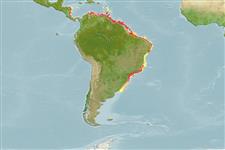Common names from other countries
>
Carangiformes (Jacks) >
Carangidae (Jacks and pompanos) > Scomberoidinae
Etymology: Oligoplites: Greek, oligos = small + Greek, hoplites = armed (Ref. 45335).
More on author: Bloch.
Environment: milieu / climate zone / depth range / distribution range
Ecologia
marinhas; estuarina bentopelágico; intervalo de profundidade ? - 40 m (Ref. 9626). Tropical; 16°N - 35°S, 89°W - 34°W
Western Atlantic: Laguna de Caratasca, Honduras to Montevideo, Uruguay.
Tamanho / Peso / Idade
Maturity: Lm ? range ? - ? cm
Max length : 50.0 cm TL macho/indeterminado; (Ref. 5217); common length : 35.0 cm TL macho/indeterminado; (Ref. 5217); peso máx. Publicado: 900.00 g (Ref. 3277)
Adults are found over soft bottoms of the continental shelf, often inshore and in estuaries. Also pelagic and encountered throughout the water column (Ref. 9626). May feed on plankton by ram-filtering. Juveniles feed mainly on planktonic crustaceans and chaetognaths, to a minor extent on benthic crustaceans and polychaetes, besides scales taken from larger fishes (Ref. 30206, 40402). Mature females generally spawn in summer. Eggs are pelagic (Ref. 35237). Marketed mostly fresh.
Life cycle and mating behavior
Maturities | Reprodução | Spawnings | Egg(s) | Fecundities | Larvas
Cervigón, F., 1993. Los peces marinos de Venezuela. Volume 2. Fundación Científica Los Roques, Caracas,Venezuela. 497 p. (Ref. 9626)
Categoria na Lista Vermelha da IUCN (Ref. 130435)
CITES (Ref. 128078)
Not Evaluated
Ameaça para o homem
Harmless
Utilização humana
Pescarias: pouco comercial; Aquário: Espécies comerciais
Ferramentas
Relatórios especiais
Descarregue XML
Fontes da internet
Estimates based on models
Preferred temperature (Ref.
115969): 22.5 - 28.1, mean 27.3 (based on 168 cells).
Phylogenetic diversity index (Ref.
82804): PD
50 = 0.5312 [Uniqueness, from 0.5 = low to 2.0 = high].
Bayesian length-weight: a=0.00759 (0.00479 - 0.01202), b=2.93 (2.80 - 3.06), in cm Total Length, based on LWR estimates for this species & Genus-body shape (Ref.
93245).
Nível Trófico (Ref.
69278): 3.8 ±0.62 se; based on food items.
Resiliência (Ref.
120179): Médio, tempo mínimo de duplicação da população 1,4 - 4,4 anos (Preliminary K or Fecundity.).
Fishing Vulnerability (Ref.
59153): Moderate vulnerability (40 of 100).
